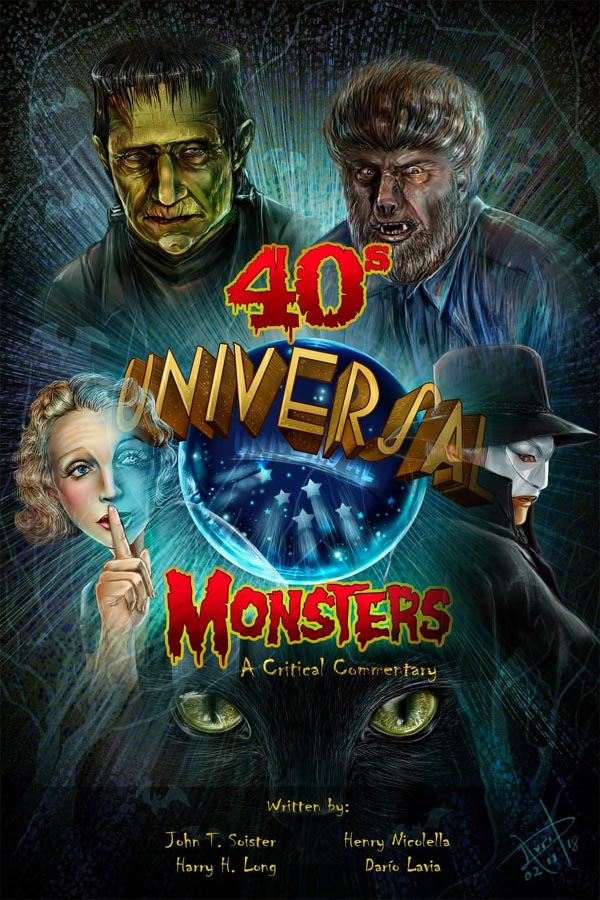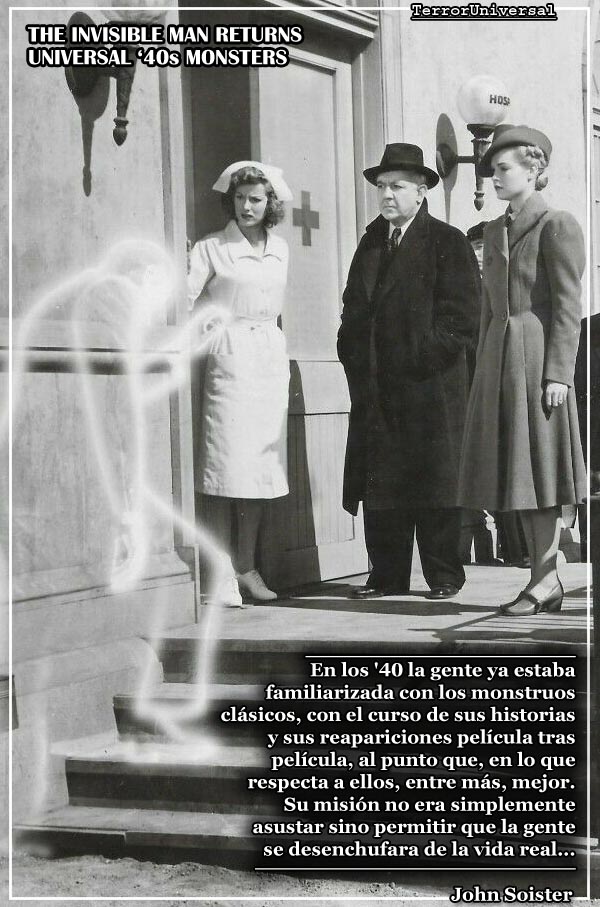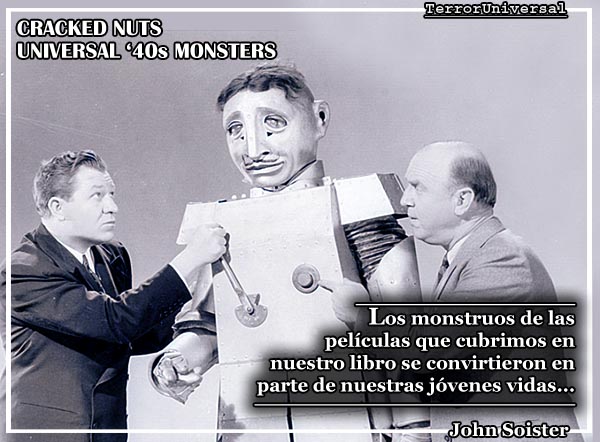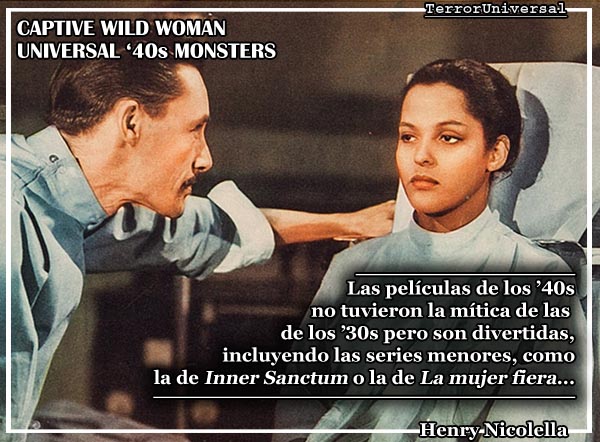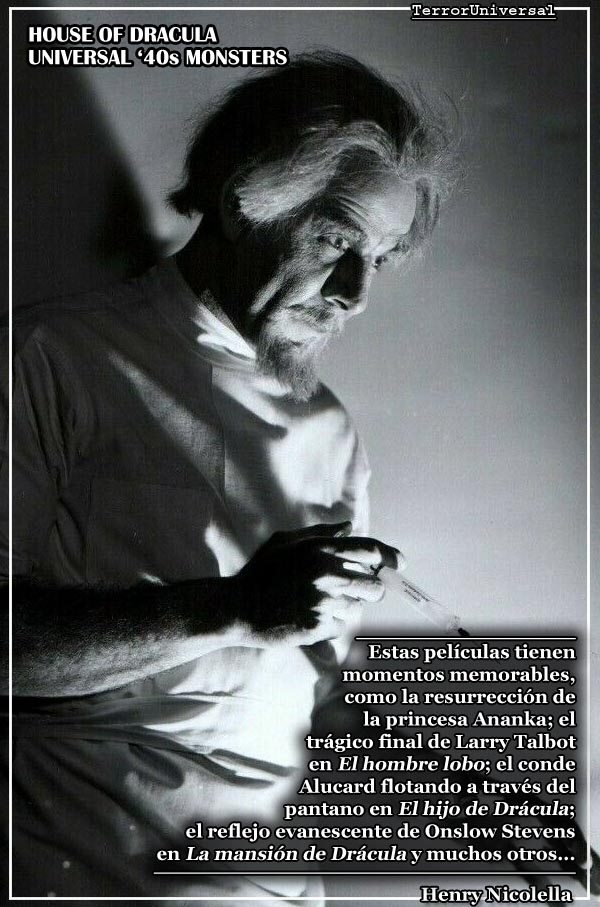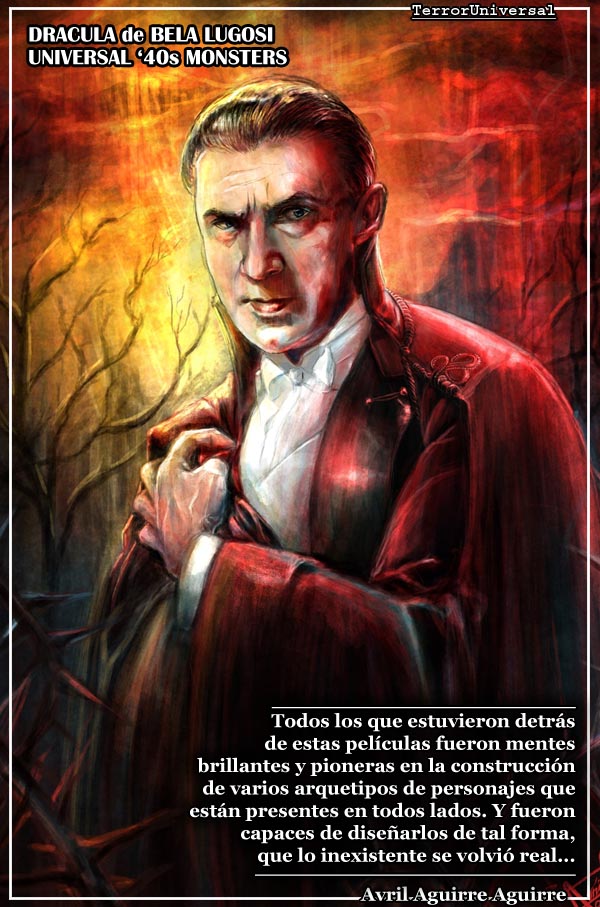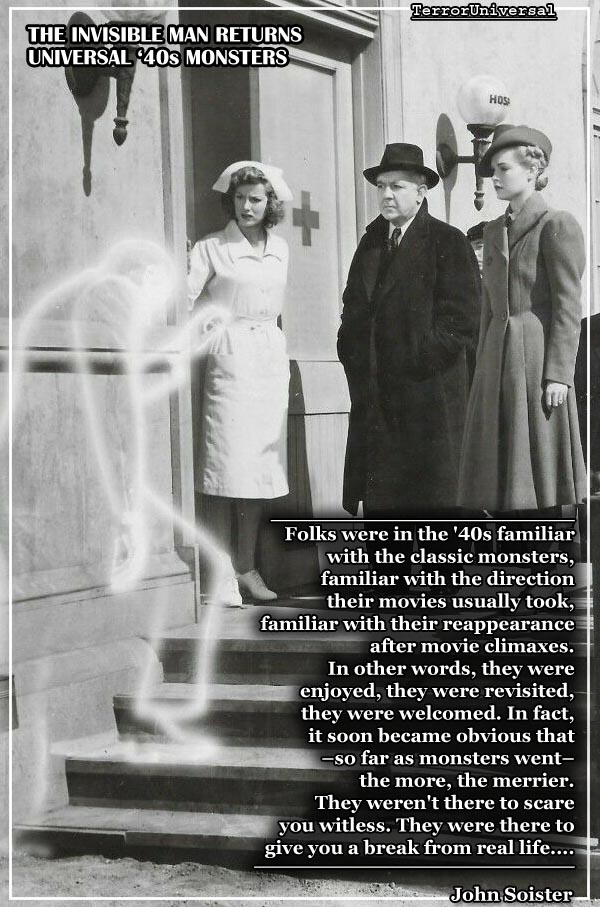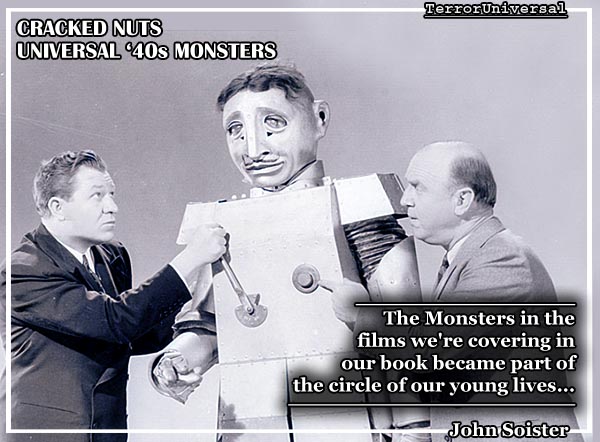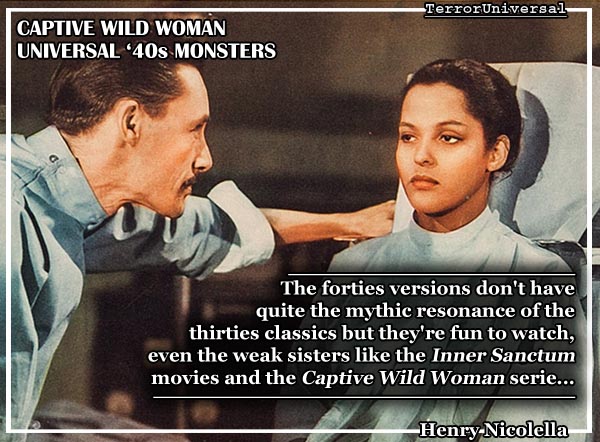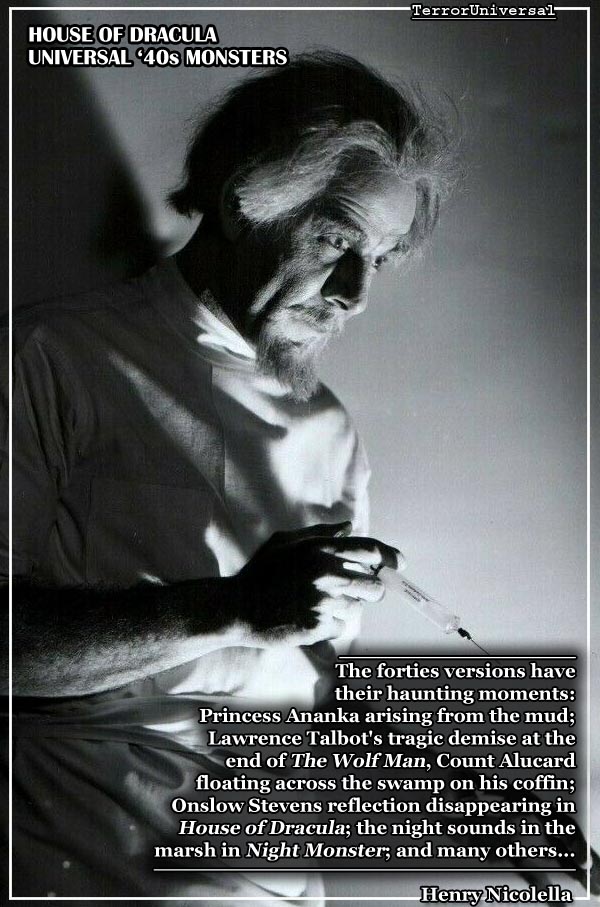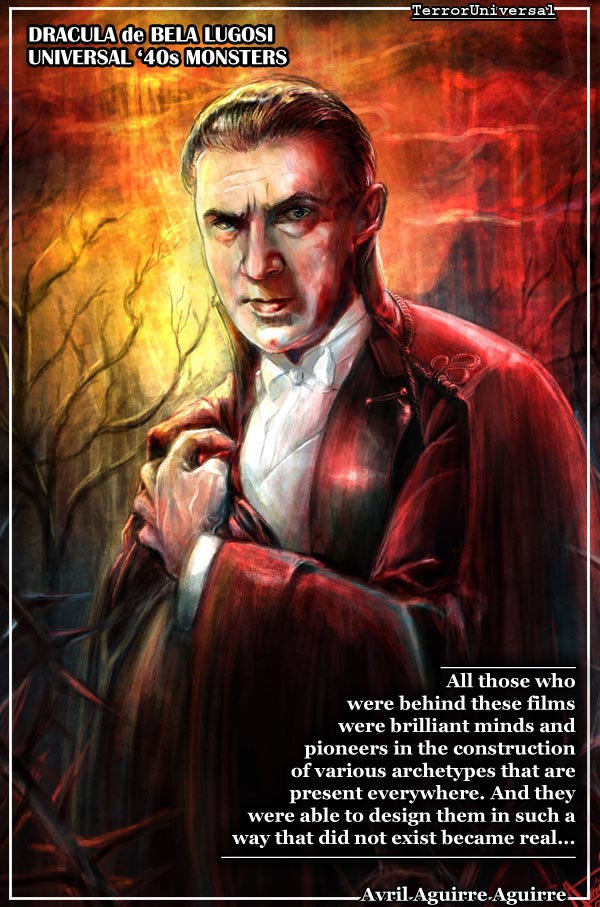 |
 |
|||
|
|
||||
En su introducción, John Soister explica que "la mayoría de las personas que son fans del género lo son porque perciben sus películas, obras o libros como algo divertido". Esa tal vez sea la premisa que guió a los autores en el visionado y reseñado de las películas, al explicar sus argumentos, contextos, valores y defectos siempre desde un punto de vista didáctico y sin dejar de transmitir el goce y la diversión que implica. Pero por sobre todo, el valor del libro es que actualiza datos y confronta valoraciones críticas no solo de la época del estreno de los filmes sino también de la copiosa bibliografía dedicada al tema en las últimas décadas. Quisimos saber algo más acerca Universal '40s Monsters así que consultamos a los autores John Soister y Henry Nicolella y también a la ilustradora de portada Avril Aguirre Aguirre, a quienes lanzamos los siguientes interrogantes: ¿Por qué (nos) interesa tanto el cine de monstruos de Universal? ¿Qué clase de fibra sensible tocan las historias de Frankenstein, Drácula, el Hombre Lobo, la Momia y el Hombre Invisible? ¿Qué ha cambiado y qué permanece intacto desde la época de su primer visionado? John Soister Los años '30 marcaron la introducción del cine de horror en el Nuevo Mundo (con el Hombre Lobo representado por su antecesor el Lobo Humano de Londres). Había habido precedentes, ya que Lon Chaney y Conrad Veidt habían trabajado para Universal, pero Quasimodo, Gwynplaine y Eric fueron incursiones solamente ocasionales en nuestro amado género. El cine de horror cobró bríos en los '30 debido a dos motivos: 1º: Evadían a la gente de la gran depresión y 2º: eran muy divertidos! Cuando las dificultades volvieron a arreciar en Europa (léase Hitler), los gustos de la gente habían cambiado. Las historias de seres grotescos y criaturas sobrenaturales dejaron paso a relatos más edificantes y tranquilizadores. No fue hasta 1939 (con el advenimiento de El hijo de Frankenstein) cuando que los norteamericanos se dieron cuenta de que el cine de horror aún podía ser antídoto para los monstruos de la vida real que amenazaban destruir a las democracias de Occidente.
En la década del '40, en medio de aquel clima político/militar, los monstruos de Universal ya no eran tan atemorizantes como antes, cuando eran desconocidos. En los '40 la gente ya estaba familiarizada con ellos, con el curso de sus historias y sus reapariciones película tras película, al punto que, en lo que respecta a los monstruos, entre más, mejor. Su misión no era simplemente asustar sino permitir que la gente se desenchufara de la vida real. Han comentado que la portada de Avril Aguirre para nuestro libro no es tan fiel a los personajes de Frankenstein y el Hombre Lobo, pero tal observación denota desconocimiento acerca del tema subyacente de nuestro libro. Ninguno de nosotros había nacido cuando estos monstruos hicieron su aparición en escena, o cuando sus vástagos volvía por segunda o tercera vez. Henry Nicolella, Harry Long y yo, que somos los más veteranos de la banda, vimos por primera vez estas películas por televisión en la década del '50. Claro está, la primera vez que salieron de las sombras, nos asustamos de muerte. Recuerdo no haber soportado mucho luego de que el monstruo de Karloff apareciera de espalda en el laboratorio de Colin Clive en Frankenstein. Dejando la TV encendida, huí a mi cuarto, cerré la puerta y me escabullí en mi cama subiéndome las cobijas por encima de mi cabeza, aguardando a que el monstruo entrara a mi habitación e hiciera lo que usualmente haría. Con mis amigos, todos chicos de 7, 8 ó 9, tal vez algún par de 10, formamos de inmediato un club de monstruos para platicar acerca de las diferentes películas de Shock Theater tan seriamente como si fuera una lección escolar. Este intercambio de ideas y opiniones podía ser "serio", pero nuestra apreciación por los monstruos no lo era... ya que eran divertidos. Y mis observaciones "vanas" (como remarcó un comentarista en Amazon), que sazonan nuestro libro, reflejan esto. Me siento en familia cuando se habla de Drácula, el monstruo de Frankenstein, Kharis, los transparentes descendientes de Griffin y demás. En aquella época estudié y conocí sus atributos, poderes y debilidades, y cuando los vuelvo a ver, me hacen sonreir como solamente alguien que me conoce puede hacerlo cuando estoy cansado o abatido por la dirección que está tomando el mundo hoy día.
El resto de las versiones posteriores de estos viejos amigos, sean realizadas por Hammer Films o Gramercy Pictures o una cantidad de estudios independientes o productoras hispanas, europeas, asiáticas o de donde sean, son más psicóticas, más violentos, menos "humanos": todo, menos divertidos. En conclusión... los monstruos de las películas que cubrimos en nuestro libro se convirtieron en parte de nuestras jóvenes vidas. De haber aparecido alguno de ellos en nuestras reuniones del club, habrían sido recibidos con aplausos, abrazos y besos, gratitud y un millón de preguntas. Tal y como para los demás chicos de nuestra generación, la televisión era como una lámpara de Aladino, con la diferencia que al frotarla, se nos aparecían personajes que no necesitaban concedernos deseos, pues ellos mismos lo eran. Henry Nicolella Al igual que otros baby boomer, encontré por primera vez a los monstruos clásicos de Universal en televisión; la única vez que los había visto en cine fue una proyección de El fantasma de la Ópera de Lon Chaney. Vi las películas de Hammer y otros filmes de monstruos en los cines barriales pero no fue hasta poco después de que las películas de Universal se dieron en los canales de televisión de nuestra área. Y rápidamente eclipsaron a las otras. No eran tan horroríficas pero eran más fascinantes. Por supuesto, la revista Famous Monsters me enseñó acerca de la vida de sus actores. A través de los años, mi amor por este universo se mantuvo y aún lo encuentro fascinante. En especial, me encantaba Bela Lugosi. Vamos, qué chico no querría ser como el conde Drácula, extravagante, sofisticado, capaz de someter a la gente con la sola voluntad y encantador para las mujeres. Desde luego, yo era más como el inarticulado monstruo de Frankenstein.
Con el correr de los años mantuve mi amor por los clásicos y aún los encuentro fascinantes. La fotografía en blanco y negro les da un aire de irrealidad que es el apropiado para las tramas, ciertamente es el vehículo ideal para la aproximación a la lucha entre el bien y el mal que es el tema de muchas de las películas. Aún me emociona ver la reacción del monstruo de Karloff al acercarse a la luz y me encanta la atmósfera mágica y gótica del Drácula de Lugosi. Y naturalmente continúa mi interés por los actores: Karloff, el caballero inglés; Lugosi, el orgulloso húngaro reducido a papeles en películas de Ed Wood y Chaney Jr. en lucha permanente con sus demonios internos.
Las películas de los cuarenta no tuvieron la mítica de las de los treinta pero son divertidas, incluyendo los opus menores, como la serie de Inner Sanctum o la de La mujer fiera. Están pobladas con magníficos actores de carácter y los guiones, si bien no siempre sofisticados, aún cumplen con las aspiraciones. Y tienen momentos memorables, como la resurrección del barro de la princesa Ananka; el trágico final de Lawrence Talbot en El hombre lobo o el conde Alucard flotando a través del pantano en El hijo de Drácula o el reflejo evanescente de Onslow Stevens en La mansión de Drácula; los sonidos nocturnos en el pantano en Monstruo nocturno y muchos otros… Su atractivo es nostálgico sí, pero por más fallos que tengan, estas películas merecen un lugar en la historia del cine. Avril Aguirre Aguirre Tuve el honor de participar con la portada del nuevo libro. Mi interés por los monstruos de Universal, el terror clásico y el cine mudo, comenzó por curiosidad. En aquel tiempo me interesaban mucho los cómics, en especial Batman, y cuando me enteré de que había una relación entre Batman y el cine clásico, me dio mucha curiosidad por ver de qué trataba. Así que empecé por las películas de monstruos de Universal y algunas películas de cine mudo como las de Lon Chaney y Conrad Veidt. En el caso de Conrad Veidt tenemos, por ejemplo, The Man Who Laughs (El hombre que ríe-1927) que fue la principal inspiración visual para el Joker de Batman. En este caso, cuando me aproximé a esta película, la vi por esa razón, sin imaginar que estaría por descubrir un mundo tan fascinante que para mí superaría cualquier cosa. Así que seguí adentrándome al resto de las películas de los monstruos de Universal y me di cuenta que, tarde o temprano, que estas películas formarían parte de mi vida. ¿Por qué digo esto? Justamente porque la expresión narrativa y visual de estas películas, muchos de los elementos que en ellas se manejan, habían estado presentes en la mayoría de las cosas que me han gustado desde que era niña...
Y cómo no va a ser así si todos los que estuvieron detrás de estas películas fueron mentes brillantes y pioneras en la construcción de varios arquetipos de personajes que están presentes en todos lados. Y fueron capaces de diseñarlos de tal forma, que lo inexistente se volvió real. Y que ahora forman parte de la imaginación colectiva y de la cultura pop que atrae a tanta gente. Pero muchas veces las personas que disfrutan que disfrutan de esta cultura pop no se detienen a pensar de donde viene. Yo los invitaría a que se empaparan de sus orígenes, porque pueden encontrarán cosas que les resultarán familiares y al mismo tiempo, tendrán un toque y un sabor únicos. Y esto fue lo que me pasó a mí. Esto me abrió la puerta a un universo en el que iba a querer permanecer y que este mundo se convertiría en mi musa artística, ya que a partir de ese momento me ha inspirado para mi trabajo como ilustradora y artista visual. Además, me acercó también a interesarme por las cosas que habían dado origen a estas películas, desde los autores de las novelas originales hasta querer saber más del contexto en el que fueron creadas algunas películas. Por ejemplo, aquellas que están cercanas a algún conflicto bélico como las guerras mundiales, cómo este terror se tradujo de una forma completamente diferente en algunas de estas películas y cómo con estos sucesos adquirieron más fuerza volviéndose películas de culto en nuestros días. De ahí también la importancia de acercarnos a un libro de crítica y opinión cinematográfica como este porque entonces no solo nos quedamos con lo que vemos sino que nos nutriremos más en nuestro conocimiento gracias a toda la investigación, análisis y reflexiones que hacen los autores, descubriendo cosas nuevas de las películas y motivándonos a verlas una y otra vez para acrecentar nuestro asombro. A continuación una pequeña book review de Universal '40s Monsters. Recuerden que pueden conseguirlo a través de la web de la editorial BearManor Media o bien, vía Amazon.
On April 1, 2021, after four years of work, '40s Universal Monsters –the volume in which John Soister, Harry Nicolella, Harry H. Long, and Dario Lavia covered Universal Picture's science-fiction and horror films produced and released between 1940 and 1948– was finally published by BearManor Media. It is the long-awaited sequel to Of Gods and Monsters (McFarland, 1999), in which Soister in soiltary had reviewed the studio's canonical titles between 1929 and 1939. The book is divided into eight chapters, one for each year of production. Each chapter offers reviews according to the official release date of each film.
In his introduction, John Soister explains that "most genre fans are genre fans because they perceive the films, plays, books, etc. to be fun." That may be the basis that guided the authors in reviewing the films, explaining their arguments, contexts, values and shortcomings always from a didactic point of view and always trying to convey the enjoyment and fun that it implies. But above all, the value of the book is that it updates data and confronts critical evaluations not only of the time the films were released but also of the rich bibliography dedicated to the subject in recent decades. We wanted to know more about Universal '40s Monsters so we consulted authors John Soister and Henry Nicolella and also cover illustrator Avril Aguirre Aguirre, to whom we asked the following questions: Why are you (us) so interested in the Universal Monsters? What kind of a chord do the stories of Frankenstein, Dracula, the Werewolf, the Mummy, and the Invisible Man touch in us? Having seen the movies again to review... What has changed and what remains since you watched them for the first time through the television box, far and long ago? John Soister Lots to reveal here. The '30s marked the introduction of the iconic Universal Monsters (with the Wolf Man represented by his more hybrid ancestor, the WereWolf of London) and –for the most part– of the horror film in the New World. There were, of course, some outliers earlier –cf. Sr. Chaney & Veidt, also working at the time for Universal– but Quasimodo, Gwynplaine, Erik, et al personified only occasional ventures into our favorite genre. Things went big time in the '30s, and most folks revelled in the Monsters because 1) they took people's minds off the Great Depression, and 2) they were fun! As trouble (i.e. Hitler) began brewing on the European continent, cinematic tastes changed. Tales of being haunted or killed by grotesque, often supernatural creatures made way for tales that were more uplifting and reassuring, and it wasn't until 1939 –with Son of Frankie et al– that Americans realized that tht kind of film STILL was an antidote to the real-life monsters looking to haunt and kill most of Western Civilization's democracies, as well as the lion's share of Asia.
Back came the Universal horrors... but in the current political/military climate, they were no longer as frightening as they had been a decade or so earlier, when they were, for the most part, unknown commodities. Folks were now (in the '40s) familiar with them, familiar with the direction their movies usually took, familiar with their reappearance after movie climaxes that should have said otherwise. In other words, they were enjoyed, they were revisited, they were welcomed. In fact, it soon became obvious that –so far as monsters went– the more, the merrier. They weren't there to scare you witless. They were there to give you a break from real life. Avril Aguirre's cover artwork for our book has been commented on as being somewhat less-than-true to the Frankie & Wolfie movie personae. But to say this is to misunderstand where the underlying theme in our book is at. None of the four of us was alive when these monsters appeared on the scene for the first time, or even when their later iterations were almost ubiquitous the second and third (and...) time around. Harry and Henry and I –the old(er) buggers in the band– first saw these characters on TV in the 1950s. Sure, the first time they crept or leapt or flew out of the shadows, we were scared. I recount my not lasting much beyond Karloff's Monster beginning to BACK INTO Colin Clive's laboratory in Frankenstein. Leaving the TV on, I ran into my room, closed the door, pulled the sheet and blanket up over my head, and waited for the Monster to back into MY room and do whatever he usually did. My friends –all of us were 7, 8, 9, maybe a couple were 10 years old–, so we immediately formed a monster club and discussed the monster-y entries in Shock Theater as seriously as if we were in grad school sitting for our comps. These sharing of thoughts and opinions may have been "serious," but our regard for the monsters was not. They were FUN! My "inane, third-grade" observations/questions that pepper my essays in our book reflect this. I was/am as much at home with Dracula, the Frankie Monster, Kharis, the latest Griffin to become transparent, etc. as I was/am with my immediate family. I know them, I know their attributes/strengths & weaknesses/powers... however you term them... and I look to them to make me chuckle as only one who is "in the know" can when I am down or tired or weary of the horrific direction the world is taking today.
Lots of later versions of these old friends of mine –whether done by Hammer Films or Gramercy Pictures or any of a number of independent studios or Hispanic/European/Asian companies or WHOMEVER– made them more psychotic, more mindlessly violent, less "human"; anything BUT fun. To wrap up... the Monsters in the films we're covering in our book became part of the circle of our young lives. Had they magically appeared in the midst of one of our club meetings, they would have been greeted with applause, hugs and kisses, gratitude and a million questions. Frankie could have given up on his quest for "Friend?" –he'd have had countless friends, as the kids of my generation found that our TVs were like Aladdin's lamp, although when we "rubbed" our magical device, we were greeted by characters who needn't have given us gifts; they were gifts in themselves. Henry Nicolella Like most baby boomer horror fans, I originally encountered the Universal classics on television. The only time I saw one at a theater was a revival showing of Chaney's Phantom of the Opera. I watched the Hammer films and other monster films at the local theaters but it wasn't until a little later that the Universal pictures played on television in our area. They quickly eclipsed all the others. They weren't scary but I found them enthralling. And of course Famous Monsters told me about the actors who played the parts. I was particularly taken with Bela Lugosi. Hey, what teenage boy wouldn't love to be like Count Dracula-flamboyant, sophisticated, able to bend people to his will and a hit with the ladies? Of course I was more like the stumbling and inarticulate Frankenstein Monster.
I kept up with my love of the classics over the years and still find them fascinating. The black and white photography gives an air of unreality appropriate to the stories and certainly works for the good vs. evil approach that is the subject of many of the films. I still find myself moved by the sight of Karloff's Monster reaching for the light and delighted with the Gothic atmosphere of Dracula and Lugosi's magic. And naturally my interest in the actors has continued: Karloff the English gentleman, Lugosi the proud Hungarian reduced to acting for Ed Wood and Chaney, Jr. struggling with his inner demons.
The forties versions don't have quite the mythic resonance of the thirties classics but they're fun to watch, even the weak sisters like the Inner Sanctum movies and the Captive Wild Woman series. They're peopled with wonderful character actors and the writing, while not often on a very sophisticated plane, delivers the goods. And they have their haunting moments: Princess Ananka arising from the mud (and the inexorable menace of the mummy); Lawrence Talbot's tragic demise at the end of The Wolf Man, Count Alucard floating across the swamp on his coffin; Onslow Stevens reflection disappearing in House of Dracula; the night sounds in the marsh in Night Monster; the villain done in by the forces of nature in Destiny of Flesh and Fantasy. And many others. Part of the appeal is nostalgia but whatever their flaws the Universal films of the forties deserve their place in movie history. Avril Aguirre Aguirre I had the honor of doing the cover of the new book Universal '40s Monsters . My interest in Universal's monsters, classic horror, and silent movies, started out of curiosity. At that time I was very interested in comics, especially Batman, and when I learned that there was a connection between Batman and classic movies, I was very curious to see what it was about. So I started with Universal's monster movies and some silent movies of Lon Chaney and Conrad Veidt. In the case of Conrad Veidt we have, for example, The Man Who Laughs (1927) that was the main visual inspiration for Batman's Joker. In this case, when I approached this film, I saw it for that reason, without imagining that I would be about to discover a world so fascinating that for me it would surpass anything. So I kept digging into the rest of Universal's monster canon and realized that sooner or later these movies would be part of my life. Why do I say this? Precisely because the stories and visual expression of these films, many of the elements that are handled in them, had been present in most of the things that I have liked since I was a child...
And how could it not be this way if all those who were behind these films were brilliant minds and pioneers in the construction of various archetypes that are present everywhere. And they were able to design them in such a way that did not exist became real. And now they are part of the pop culture that attracts so many people. But many people who enjoy this pop culture don't stop to think about where it comes from. I would invite them to find out about its origins, because they can trace things that are familiar to them and, at the same time, they will discover an unique flavor touch. And this is what happened to me. This opened the door for me to an universe in which I would want to stay and that this world would become my muse, my artistic inspiration, since from that moment it has inspired me for my work as an illustrator and visual artist. Also, it made me interested in the origins of these films, from the authors of the seminal novels to know more about the context in which some films were made. For example, those that are close to a war times such as the World War; how this terror was translated in a completely different way in some of these films and how with these events they acquired more force becoming cult films in our days. De ahí también la importancia de acercarnos a un libro de crítica y opinión cinematográfica como este porque entonces no solo nos quedamos con lo que vemos sino que nos nutriremos más en nuestro conocimiento gracias a toda la investigación, análisis y reflexiones que hacen los autores, descubriendo cosas nuevas de las películas y motivándonos a verlas una y otra vez para acrecentar nuestro asombro. Hence also the importance of approaching a book of film criticism and opinion like this one because then we not only stay with what we see but we will nourish ourselves in our knowledge thanks to all the research, analysis and thought that the authors do, discovering new things from the movies and motivating us to see them again and again to increase our amazement.
Here is a short book review of Universal '40s Monsters. Remember that you can get it through BearManor Media website or via Amazon (you can enable english subtitles in the settings control).
| atrás | recomendar esta página | enviar comentarios | arriba | |
© 2025 Terror Universal |

